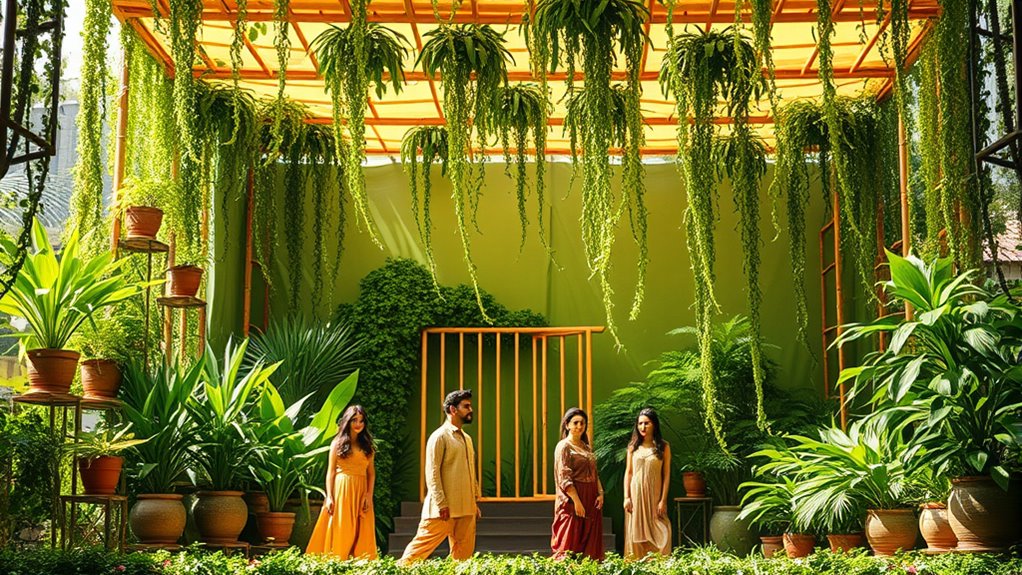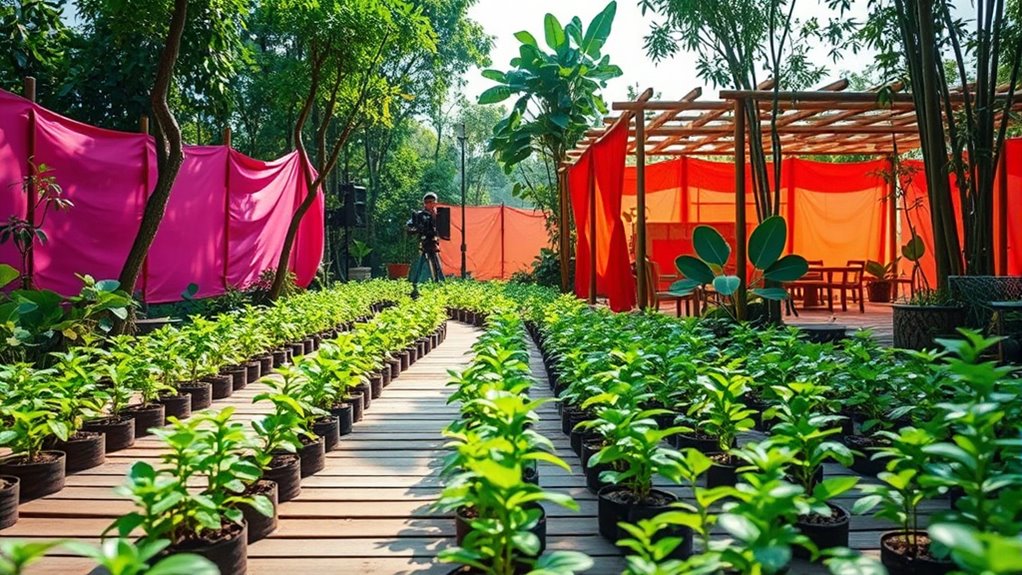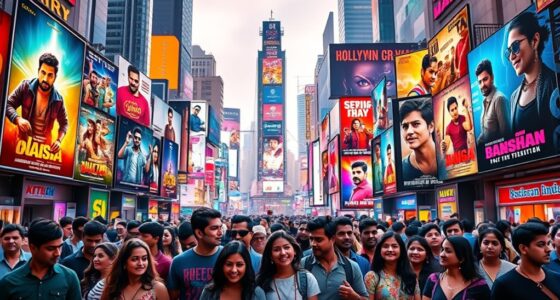In Bollywood, eco-friendly sets are built using sustainable materials like recycled and biodegradable options, cutting down on waste and environmental impact. Studios incorporate renewable energy sources such as solar panels and wind power, reducing reliance on fossil fuels. They also design modular, reusable sets that can be repurposed for multiple scenes, markedly cutting waste. These eco-conscious practices are becoming industry standards, paving the way for more sustainable filmmaking—stay tuned to discover more about these green innovations.
Key Takeaways
- Bollywood studios prioritize using recycled, biodegradable, and eco-friendly materials like bamboo for set construction.
- Solar panels and renewable energy sources power studio operations, reducing reliance on fossil fuels.
- Sets are designed to be modular and reusable, minimizing waste and promoting a circular economy.
- Waste management practices include recycling, reusing materials, and designing for easy dismantling and repurposing.
- Industry-wide, eco-friendly set building is becoming standard, inspiring sustainable practices across the entertainment sector.

Bollywood is increasingly embracing eco-friendly sets to reduce its environmental impact and promote sustainability. As someone involved in film production, you’ll notice that many studios and directors are now prioritizing green practices, especially when it comes to building sets. This shift isn’t just about being environmentally conscious; it’s about setting a new standard in the industry. One of the key strategies is the use of sustainable materials. Instead of traditional wood or plastic, producers opt for recycled materials, bamboo, or other biodegradable options that lessen waste and reduce the carbon footprint. These materials are carefully selected to guarantee durability while being environmentally friendly. When you’re designing or constructing a set, sourcing sustainable materials becomes a priority, and it often involves collaborating with suppliers who specialize in eco-conscious products. This approach not only minimizes environmental harm but also encourages a circular economy, where waste is repurposed rather than discarded.
Another essential aspect of building eco-friendly sets is harnessing renewable energy. You might see solar panels integrated into studio roofs or portable solar-powered equipment used during outdoor shoots. Using renewable energy sources considerably cuts down on reliance on fossil fuels, which are major contributors to greenhouse gas emissions. When you work on a project with renewable energy, you’re actively reducing the carbon footprint associated with lighting, sound equipment, and other set operations. Many studios are now investing in solar farms or wind energy partnerships to power their entire sets, making sustainability a core part of their infrastructure. This not only reduces pollution but also demonstrates a commitment to long-term environmental responsibility. Additionally, understanding thermal energy transfer principles can help optimize energy use in set design, ensuring that heating or cooling systems operate efficiently and reduce overall energy consumption.
Incorporating eco-friendly practices also means rethinking waste management on set. Recycling and reusing materials become standard procedures. You might find that sets are designed to be dismantled and repurposed for future projects, preventing unnecessary waste. This approach fosters innovation, as you learn how to create versatile, modular sets that can be adapted for different scenes and productions. The combination of sustainable materials and renewable energy usage results in a more conscious, eco-friendly production environment. It’s a tangible way to show that Bollywood is serious about reducing its environmental impact.
As you participate in or observe these changes, it’s clear that eco-friendly sets aren’t just a trend—they’re a crucial part of the industry’s future. By choosing sustainable materials and harnessing renewable energy, Bollywood is proving that entertainment and environmental responsibility can go hand in hand. This movement not only benefits the planet but also inspires others in the industry to adopt greener practices, making sustainability a standard rather than an exception.
Frequently Asked Questions
How Do Eco-Friendly Sets Impact Film Production Costs?
Eco-friendly sets can influence your film production costs by initially requiring investments in sustainable sourcing and eco-friendly materials. However, when you do a thorough cost benefit analysis, you’ll find they often save money in the long run through reduced waste, energy efficiency, and potential incentives. These sustainable choices may seem costly upfront, but they can lower overall expenses and boost your project’s eco-credibility, making your production both greener and more cost-effective.
What Materials Are Most Commonly Used in Green Set Construction?
You’ll find that recyclable materials and sustainable building practices are most commonly used in green set construction. These include recycled wood, eco-friendly paints, and biodegradable props. Using such materials reduces environmental impact and promotes sustainability. By choosing recyclable options, you help minimize waste and support eco-conscious filmmaking. This approach makes the sets not only environmentally friendly but also cost-effective, aligning with the growing demand for sustainable production methods.
Are Eco-Friendly Sets Suitable for All Genres of Films?
Did you know eco-friendly sets can fit any genre? You might think their set design limits creativity, but that’s not true. These sustainable options offer genre flexibility, whether it’s a romantic storyline, action-packed scenes, or fantasy worlds. You can craft immersive environments without compromising eco-standards. So, you’re not restricted—green sets adapt beautifully, proving that sustainability and diverse storytelling go hand in hand.
How Do Bollywood Productions Measure the Success of Sustainable Sets?
You measure the success of sustainable sets by tracking their carbon footprint reduction and observing audience perception. You compare energy consumption, waste management, and resource reuse before and after implementation. Positive audience reactions and industry recognition also serve as benchmarks. When your sets minimize environmental impact and gain appreciation from viewers, it shows your eco-friendly efforts resonate and make a meaningful difference in filmmaking practices.
What Challenges Do Filmmakers Face When Switching to Eco-Friendly Sets?
When switching to eco-friendly sets, you face challenges like ensuring sustainable sourcing of materials and obtaining environmental certifications. You must balance eco-conscious choices with project budgets and timelines, which can be demanding. Additionally, convincing stakeholders of the long-term benefits requires effort. You might also encounter limited availability of sustainable resources, making it harder to meet production needs while maintaining eco-friendly standards.
Conclusion
As you witness Bollywood’s shift towards eco-friendly sets, you’ll see a movement blossoming like a garden in spring. By choosing sustainable materials and innovative designs, filmmakers are planting seeds for a greener future. Every eco-conscious set is a small step towards protecting our planet, proving that even in the glitz and glamour, environmental responsibility can flourish. So, keep your eyes open—you’re part of a change that’s as vibrant and essential as the industry itself.









